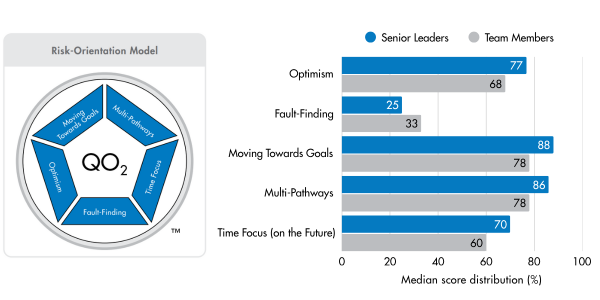
Change is everywhere and it’s not slowing down.
Today, 96% of organisations are navigating some form of transformation*. From digital initiatives to culture shifts, change is the norm. But one thing many organisations overlook is that leaders and the broader team rarely experience change in the same way.
Our latest global data (drawn from over 15,000 profiles worldwide) highlights a clear difference:
- Senior leaders tend to see change as an opportunity, leaning into risk and moving forward decisively.
- Team members are more cautious, often focusing on potential obstacles and expressing less optimism.
How senior leaders and team members differ by Risk-Orientation:

Data extracted from the Opportunities-Obstacles Quotient (QO2) Profile.
This difference has real consequences. Research shows that 39% of employees resist change and productivity can drop by as much as 50% during major initiatives. Other studies also indicate that up to 70% of change efforts ultimately fail*.
When leaders assume their teams share their mindset about change, morale and momentum often take a hit.
Why this gap matters
Leaders often have more context, influence, and control over the changes they drive, which makes it easier for them to embrace risk and stay optimistic.
Team members, on the other hand, are closer to the operational impact and less involved in shaping the vision. That makes it more natural for them to focus on what could go wrong and why it might not work.
When these different mindsets go unrecognised, you risk:
- Lower morale and trust.
- Resistance that slows momentum.
- Missed opportunities to address valid concerns early.
How to bridge the gap
Even if you’re not a trained leadership and development coach, there are practical steps you can take to support both leaders and teams through change. Here are five you can start with:
1. Acknowledge different perspectives
Understand that leaders and employees naturally view change through different lenses. Be prepared to provide more clarity, reassurance and encouragement for team members and identify champions within the team who can model positive engagement.
2. Create space for feedback
Encourage employees to share concerns. Listen carefully, as team members may spot risks or challenges leaders haven’t considered. Remember, data shows that team members often bring strong fault-finding skills that can improve plans if addressed constructively.
3. Make it relevant
Show employees how the change will improve their day-to-day experience. Use specific, relatable examples that make the benefits immediately tangible, not in a distant future.
4. Keep communication flowing
Check in regularly with updates and opportunities for questions. Don’t wait for formal reviews to find out something isn’t landing.
5. Celebrate progress
Highlight and reward small wins along the way to maintain momentum and remind people that progress is being made. Also celebrate different types of achievements that span the whole team, not just the champions of change.
These straightforward actions can help teams feel heard, valued and more ready to embrace change.
When you’re ready to go deeper
If you want to go beyond these first steps and really understand how your people approach change, the QO2 Profile, based on our Risk Orientation Model, can help.
The Opportunities-Obstacles Quotient (QO2) Profile reveals how individuals, teams and organisations perceive and respond to change, risk and uncertainty. It shows you whether people lean more towards opportunities or obstacles and how that mindset shapes how they lead, collaborate, and adapt.
With this insight, you can:
- Tailor your communication to different mindsets.
- Align expectations between leaders and team members.
- Anticipate resistance before it surfaces.
- Provide targeted support where it’s needed most.
Want to learn more about the QO2 Profile, or how we can help you guide your teams through change with confidence? We’re always happy to chat.
*Data from:
- Succeeding in disruptive times (KPMG. 2016)
- Personality, context, and resistance to organizational change (Oreg. 2006)
- Change Management: The People Side of Change (Prosci. 2016)
- The determinants of organizational change management success (Errida and Lotfi. 2021)
